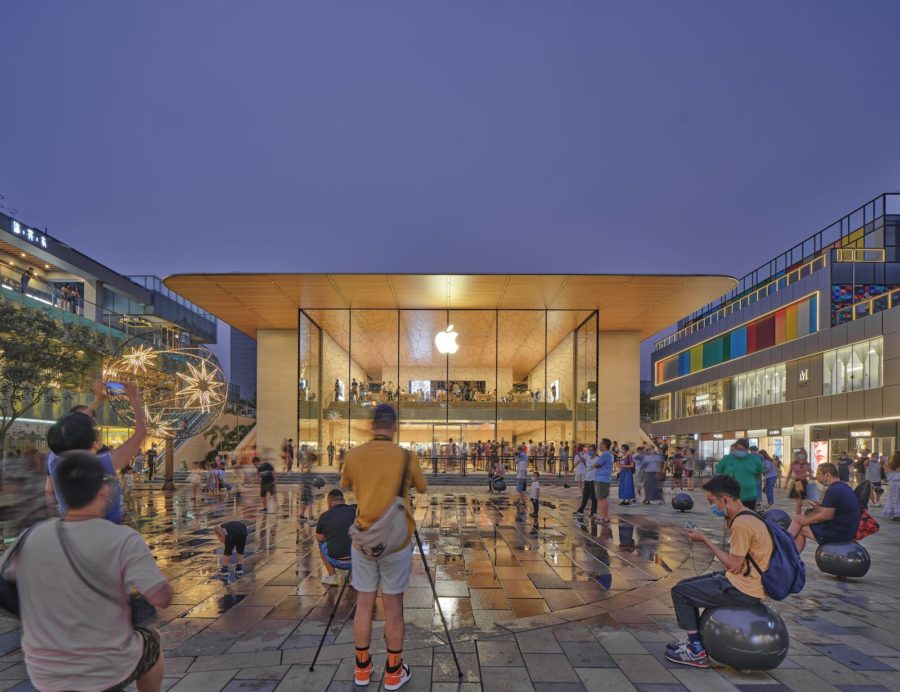このプロジェクトは、外国人観光客をメインターゲットとしたサービスアパートメントホテルである。外国人観光客の多くは、長期滞在や複数人での滞在といった特徴があり、このホテルでは、このようなゲストの滞在に特化した宿泊施設をつくるためのさまざまな工夫が施されている。
敷地は、日本の古都京都であり、鴨川に近い特徴的な場所である。河の多い京都特有の風土から生まれた、柔らかな色彩や日本文化の感じられる滞在空間を、日本で古くから親しまれた「屏風」をモチーフとして実現しようと考えた。
「屏風」は空間を間仕切る、または装飾するといった2つの機能を持っており、日本の建築様式において重要な役割を担ってきた。また、折り曲げるという単純な構造により生まれる「くの字」の形態には、「内」と「外」のように、相反する2つの空間が生まれる。
「屏風」の特徴である「内」と「外」を、ラウンジに求められる「賑わい」と「くつろぎ」の空間に置き換え、ホテルの滞在空間にあるべき2つの空間の質を共存させる構成とした。くつろぎが生まれる、くの字の内側にはソファなどを設えた。また、くの字の外側は背景となり、装飾的なものとして機能している。このような、日本的なラウンジ空間は、旅の記憶に残り、特別な空間体験となることを期待している。(佐々木達郎)
Hotel where folding screens create a space of 'liveliness' and 'relaxation' in the lounge
This project is a serviced hotel mainly targeting foreign tourists. Many foreign tourists are characterized by staying for long periods and in groups of several people, and the hotel has a number of innovations designed to create accommodation specifically for such guests.
The site is in Kyoto, the ancient capital of Japan, and is characterized by its proximity to the Kamo River. The idea was to create a space for guests to stay with soft colors and a sense of Japanese culture, born from the unique climate of Kyoto with its many rivers, using the motif of the ‘byobu,’ an ancient and familiar Japanese folding screen.
Folding screens have a dual function of dividing space and decoration and have played an important role in Japanese architectural styles. The simple structure of the folding screen creates a ‘Ku-no-ji’ shape, which is like an ‘inside’ and an ‘outside,’ two contradictory spaces.
The ‘inside’ and ‘outside’ characteristics of the ‘folding screen’ are replaced by the ‘liveliness’ and ‘relaxation’ required of a lounge. The structure is designed so that the two qualities of space that should exist in a hotel’s accommodation space can coexist. The inside of the U-shape, where relaxation is created, is furnished with sofas. The outside of the U-shape serves as a backdrop and decorative element. We hope that this kind of Japanese lounge space will remain in the memory of the traveler and become a special spatial experience. (Tatsuro Sasaki)
【MIMARU 河原町五条】
所在地:京都市下京区西高瀬川筋五条下る平居町17番1
用途:ホテル・ホステル
クライアント:コスモスイニシア
竣工:2019年
設計:佐々木達郎建築設計事務所(内装)
担当:佐々木達郎、中島紀子*、渡辺めぐみ*(*は元所員)
施工:高松建設
撮影:Nacása & Partners
工事種別:新築
構造:鉄筋コンクリート造
規模:地上5階
敷地面積:1,631.64m²
建築面積:1,299.38m²
延床面積:5,988.22m²
【MIMARU KARAWAMACHI GOJO】
Location: 17-1, Hirai-cho, Gojosagaru, Nishitakasegawasuji, Simogyoku, Kyoto-city, Kyoto, Japan
Principal use: Hotel
Client: COSMOS INITIA
Completion: 2019
Architects: Tatsuro Sasaki architects
Design team: Tatsuro Sasaki, Tomoko Nakajima*, Megumi Watanabe* ( * former staff)
Contractor: Takamatsu Corporation
Photographs: Nacása & Partners
Construction type: New Building
Main structure: Reinforced Concrete construction
Building scale: 5 Stories
Site area: 1,631.64m²
Building area: 1,299.38m²
Total floor area: 5,988.22m²








